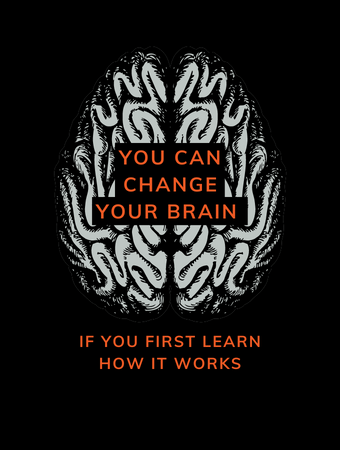
After years of fighting chronic illness, I found that my limbic system was stuck in a fight-or-flight response. For so long, I lived in fear of the next diagnosis, always waiting for another bad thing to happen. My brain walked pathways of sickness again and again until those routes became deep and prominent. My body, out of habit, wanted to tread through those pathways because it was easier than carving out something new. It was as if my brain had forgotten how to project health and wellness over my body. I needed neural retraining to rewire my brain from a state of perpetual sickness to a state of healthy equilibrium.
In Neural Retraining I – How I Healed My Brain and Rewriting a Thousand Dreams, I talk about my experience with the Dynamic Neural Retraining System (DNRS). I used DNRS to purposefully guide my brain away from pathways of sickness by strategically cutting new routes to wellness. In this post, I will focus on what I learned about my brain through the experience of neural retraining.
THE CUP HALF-EMPTY
In order to rewire my brain, I first had to learn how my brain works…how it stores memories and how it processes the world around me. It’s not something that I’d ever examined before. I think we all know ourselves well enough to know if we’re “cup half-full” or “cup half-empty” people, but how that plays out in our day to day lives might be an enigma, even to ourselves.
During the course of neural retraining, I learned that my brain naturally stores memories in the negative. Take my son’s birth as an example. Of course, I was overjoyed by the first cries my son ever breathed. In fact, I my overflow of love and joy moved me to tears. All of that happened while I was strapped to an operating table following an emergency c-section. In the following days, my incision became infected and recovery was miserably difficult. Given such a mixture of emotions (love, joy, thankfulness, pain, fear, anxiety, etc.), my brain instinctually defers to the negative and stores memories as such. I know this, because when directed to pull out a purely positive memory, I couldn’t do it. Even events that should have been happy in my brain were all mixed up with the weight of negative emotions.

Where does your brain store memories?
FILLING THE CUP
Learning this about myself has been a huge game changer. Because I know this is my brain’s natural tendency, I can purposefully address the issue by redirecting the storage of new memories. At the end of each day, I can think through the events I experienced and focus on positive emotions and outcomes. I can tell my brain where to store new memories. I can even go in and refile old ones by building a new structure in which to house the old information. (That takes a lot of time and effort, but I’ve found it to be worth it…especially where big moments are concerned.)

Be purposeful with old and new memories.
This idea also applies to the filter through which I view the world around me. It’s possible to take pre-existing perceptions about the world and your place in it, and shift them to a healthier lens for living. Even though my natural instinct for life is to see a cup half-full, I can spend time intentionally filling the cup to tip the weight of my life experiences from negative to positive.
THE “TYPE A” CURSE
I’ve known from a young age, that I’m a classic “Type A” personality. I’m a self-motivated, goal oriented, driven, hardworking perfectionist. But along with these things that elevate my professional productivity, I’m also impatient with others, chronically stressed, work obsessed, and easily irritated when others don’t maintain the same work ethic that I do. The negative tendencies associated with being a “Type A” have become a more recent focus for me to work through. I know that these character flaws have the potential to create negative thoughts and attitudes in my life. They tint the lens through which I view the world, and like negative memory storage, my life and health are improved when I take the time to rewire or refocus these tendencies toward positivity.
I’ll give one (vulnerable) example of how I’m working through some of this now. While I’m a true “Type A,” my husband is definitely not. He lacks the perfectionist gene that I’m blessed (or cursed?) with. So…when my husband helps with the laundry, I feel the need to refold my pants that he already folded. I also rearrange the dishwasher that he loaded, because I can fit twice as many dishes in there. I naturally hyper focus on the things I perceive as negative.
When I do bow to negativity, irritation builds up inside of me so that it clouds my view of our relationship. Instead of being irritated that his efforts are not as productive as mine, I now try to focus my attention on the fact that I have a spouse who makes an effort to help around the house. For my health and the health of our relationship, gratefulness needs to purposefully replace my natural instinct toward irritation.
POSITIVITY AND GRATEFULNESS ARE THE ONGOING CURE
When your brain is conditioned to live one way, it’s hard to change those natural patterns and procedures. It’s not impossible, though. The cure requires ongoing maintenance. Every day, I purposefully focus on positive memory storage. I tell my memories where to go in my brain. I tell my brain how I want to remember certain events. I focus on beauty in the world around me. To nurture my relationship with my spouse, I write down things about him and our relationship that lead me to positive emotions and a state of gratefulness. I pray that God would grant peace and positive change over my life.

Gratefulness is an ongoing practice.
The cure is hard work, especially in the beginning, but the brain is remarkably pliable. Every time that I find beauty on a bad day, or gratefulness over irritation…every time I that I purposefully store a memory in its positive location, I deepen those pathways. As they deepen, they become easier to walk.
If you really study yourself and the way your brain works, you may not like what you see. You may find that food is a comfort addiction. You may find that you habitually lash out in anger before you take time to process a situation. You may find that you let fear or trauma rule over your life to the exclusion of personal relationships. You may find that you control and manipulate others when your own life feels out of control. There’s potential to change whatever happens in your brain, even if it’s been happening since childhood.
You CAN change.
You CAN improve from wherever you are.
You CAN rewire your brain.
You CAN achieve real healing.
Neural retraining is for everyone.






Leave a Reply
You must be logged in to post a comment.